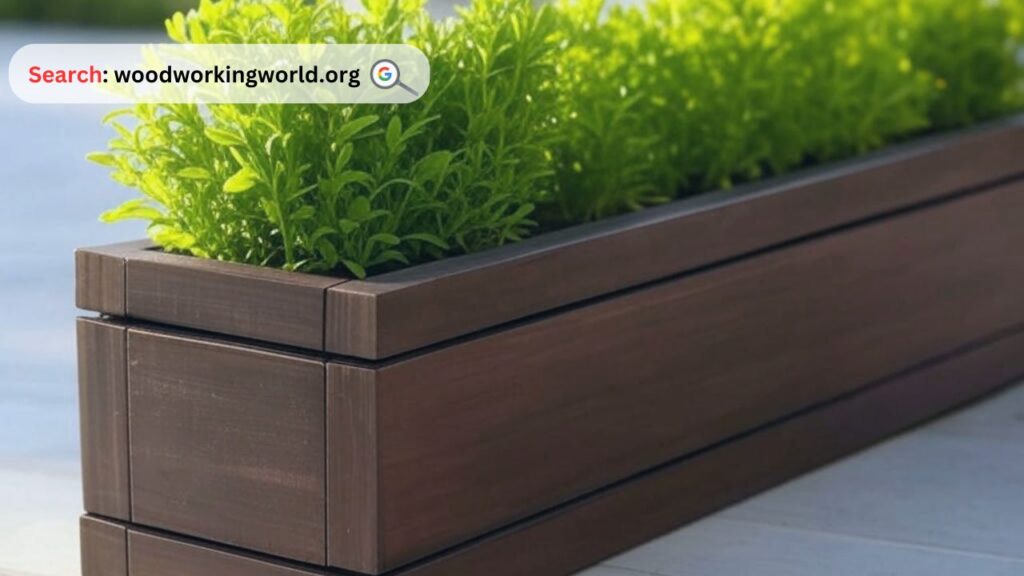Upgrade your garden with a stylish rectangle wood planter box! Perfect for modern gardening—get design tips, DIY ideas & top picks. Click to explore now!
Modern gardening has evolved significantly, with a growing emphasis on stylish and practical elements that enhance both indoor and outdoor spaces. A rectangle wood planter box is an ideal choice for gardening enthusiasts who want to bring elegance and functionality to their home gardens. Whether you have a balcony, patio, or backyard, these planter boxes provide a sleek and space-efficient way to grow flowers, herbs, and vegetables.

In this comprehensive guide, we will explore everything about rectangle wood planter boxes, including their benefits, materials, a step-by-step guide to building your own, a comparison table, and answers to frequently asked questions.
Benefits of a Rectangle Wood Planter Box
A rectangle wood planter box offers a range of benefits for both seasoned and novice gardeners:
- Aesthetic Appeal: The natural wood finish complements modern, rustic, and traditional garden designs.
- Space Optimization: Its rectangular shape allows for efficient use of space, making it ideal for narrow areas like balconies or window sills.
- Durability: When made with high-quality wood, these planter boxes can withstand various weather conditions.
- Customizability: Wood can be stained, painted, or carved to fit your garden’s theme.
- Sustainability: Many wooden planter boxes are made from eco-friendly or reclaimed wood, reducing environmental impact.
👉 Build 16,000+ Projects with Step-by-Step Plans—No Big Workshop or Costly Tools Needed! Start Now!
Step-by-Step Guide to Building a Rectangle Wood Planter Box
Materials Needed
- Wood planks (cedar, redwood, or treated pine)
- Measuring tape
- Saw
- Drill and screws
- Wood glue
- Sandpaper
- Waterproof wood stain or sealant
- Plastic liner (optional)
- Soil and plants
Step 1: Measure and Cut the Wood
Determine the desired dimensions of your planter box. A common size is 24 inches long, 12 inches wide, and 12 inches deep. Use a saw to cut the wood accordingly:
- 2 side panels: 24 inches long
- 2 end panels: 12 inches wide
- 1 bottom panel: 24 x 12 inches
Step 2: Sand the Edges
Smooth the cut edges with sandpaper to prevent splinters and ensure a polished look.
Step 3: Assemble the Box
- Apply wood glue along the edges where the panels meet.
- Secure the panels together with screws using a drill.
- Reinforce the corners with additional screws for stability.
Step 4: Add Drainage Holes
Drill small drainage holes in the bottom panel to prevent water from accumulating and causing root rot.
Step 5: Apply a Waterproof Finish
To enhance durability, coat the wood with a waterproof stain or sealant. This will protect it from moisture and prolong its lifespan.
Step 6: Add a Liner (Optional)
Lining the planter with plastic sheeting can further extend its longevity by preventing soil moisture from direct contact with the wood.
Step 7: Fill with Soil and Plants
Use high-quality potting soil suitable for your chosen plants. Arrange the plants inside the planter and water them as needed.
Expert tips on Woodworking 🌿📦 Watch now!

Comparison Table: Wood Types for Planter Boxes
| Wood Type | Durability | Resistance to Moisture | Aesthetic Appeal | Price Range |
|---|---|---|---|---|
| Cedar | High | Excellent | Rich, warm tones | $$$ |
| Redwood | High | Excellent | Deep red hues | $$$$ |
| Treated Pine | Moderate | Good | Customizable with paint | $$ |
| Teak | Very High | Excellent | Elegant golden-brown | $$$$$ |
| Oak | High | Moderate | Classic and sturdy | $$$$ |
Tips for Maintaining Your Rectangle Wood Planter Box
- Reapply Sealant Annually: Protect your planter by sealing it every year.
- Avoid Overwatering: Excess moisture can cause wood rot over time.
- Elevate the Planter: Placing it on small feet or bricks improves air circulation and drainage.
- Regular Cleaning: Wipe the wood clean to prevent mold and mildew growth.
Quote for Inspiration
“Gardening adds years to your life and life to your years.” – Unknown
Frequently Asked Questions (FAQ)
1. What is the best wood for a rectangle planter box?
Cedar and redwood are the best choices due to their natural resistance to decay and pests.
2. How deep should a planter box be for vegetables?
A depth of at least 12 inches is recommended for most vegetables to allow proper root growth.
3. Can I use untreated wood for my planter box?
Yes, but it may not last as long. Using a sealant or liner can help extend its lifespan.
4. How do I prevent my wooden planter from rotting?
Use rot-resistant wood, apply a sealant, and ensure proper drainage with holes in the bottom.
5. Can I place a rectangle wood planter box indoors?
Yes! Just ensure you use a liner to prevent water damage and place a tray underneath to catch excess water.
6. What plants grow best in a rectangle wood planter?
Herbs (basil, thyme, rosemary), flowers (petunias, marigolds), and vegetables (lettuce, spinach, radishes) thrive in planter boxes.
7. How often should I water plants in a wooden planter?
Watering frequency depends on the plant type and climate. Check soil moisture levels regularly to avoid overwatering.

Conclusion
A stylish rectangle wood planter box is an excellent addition to any modern garden. It offers both aesthetic and functional benefits, allowing you to grow a variety of plants in a sleek, space-efficient design. Whether you build your own or purchase a pre-made one, maintaining your planter properly will ensure it lasts for years. Happy gardening!
👉 Click To Order Teds Woodworking With A 60-Money-back Guarantee From – Official Website